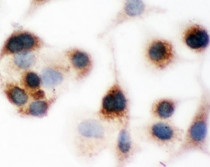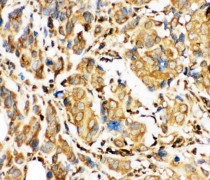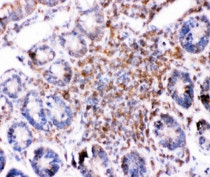ARG58114
anti-Bid antibody
anti-Bid antibody for ICC/IF,IHC-Formalin-fixed paraffin-embedded sections,Western blot and Human,Rat
Cancer antibody; Cell Biology and Cellular Response antibody; Cell Death antibody; Metabolism antibody; Apoptosis Marker antibody; Pro-apoptotic Bcl2 protein antibody
Overview
| Product Description | Rabbit Polyclonal antibody recognizes Bid |
|---|---|
| Tested Reactivity | Hu, Rat |
| Tested Application | ICC/IF, IHC-P, WB |
| Host | Rabbit |
| Clonality | Polyclonal |
| Isotype | IgG |
| Target Name | Bid |
| Antigen Species | Human |
| Immunogen | Recombinant protein corresponding to aa. 1-195 of Human Bid. |
| Conjugation | Un-conjugated |
| Alternate Names | p22 BID; BID; p15 BID; p11 BID; BH3-interacting domain death agonist; p13 BID; FP497 |
Application Instructions
| Application Suggestion |
|
||||||||
|---|---|---|---|---|---|---|---|---|---|
| Application Note | * The dilutions indicate recommended starting dilutions and the optimal dilutions or concentrations should be determined by the scientist. | ||||||||
| Observed Size | 22 kDa |
Properties
| Form | Liquid |
|---|---|
| Purification | Affinity purification with immunogen. |
| Buffer | PBS, 0.025% Sodium azide and 2.5% BSA. |
| Preservative | 0.025% Sodium azide |
| Stabilizer | 2.5% BSA |
| Concentration | 0.5 mg/ml |
| Storage Instruction | For continuous use, store undiluted antibody at 2-8°C for up to a week. For long-term storage, aliquot and store at -20°C or below. Storage in frost free freezers is not recommended. Avoid repeated freeze/thaw cycles. Suggest spin the vial prior to opening. The antibody solution should be gently mixed before use. |
| Note | For laboratory research only, not for drug, diagnostic or other use. |
Bioinformation
| Database Links |
Swiss-port # P55957 Human BH3-interacting domain death agonist Swiss-port # Q9JLT6 Rat BH3-interacting domain death agonist |
|---|---|
| Gene Symbol | BID |
| Gene Full Name | BH3 interacting domain death agonist |
| Background | This gene encodes a death agonist that heterodimerizes with either agonist BAX or antagonist BCL2. The encoded protein is a member of the BCL-2 family of cell death regulators. It is a mediator of mitochondrial damage induced by caspase-8 (CASP8); CASP8 cleaves this encoded protein, and the COOH-terminal part translocates to mitochondria where it triggers cytochrome c release. Multiple alternatively spliced transcript variants have been found, but the full-length nature of some variants has not been defined. [provided by RefSeq, Jul 2008] |
| Function | The major proteolytic product p15 BID allows the release of cytochrome c (By similarity). Isoform 1, isoform 2 and isoform 4 induce ICE-like proteases and apoptosis. Isoform 3 does not induce apoptosis. Counters the protective effect of Bcl-2. [UniProt] |
| Research Area | Cancer antibody; Cell Biology and Cellular Response antibody; Cell Death antibody; Metabolism antibody; Apoptosis Marker antibody; Pro-apoptotic Bcl2 protein antibody |
| Calculated MW | 22 kDa |
| PTM | TNF-alpha induces a caspase-mediated cleavage of p22 BID into a major p15 and minor p13 and p11 products. p15 BID is ubiquitinated by ITCH; ubiquitination results in proteasome-dependent degradation. [UniProt] |
Images (4) Click the Picture to Zoom In
-
ARG58114 anti-Bid antibody ICC image
Immunocytochemistry: A549 cells stained with ARG58114 anti-Bid antibody.
-
ARG58114 anti-Bid antibody IHC-P image
Immunohistochemistry: Paraffin-embedded Human breast cancer tissue stained with ARG58114 anti-Bid antibody.
-
ARG58114 anti-Bid antibody WB image
Western blot: HeLa, COLO320, Jurkat and SKOV cell lysates stained with ARG58114 anti-Bid antibody.
-
ARG58114 anti-Bid antibody IHC-P image
Immunohistochemistry: Paraffin-embedded Rat intestine tissue stained with ARG58114 anti-Bid antibody.









